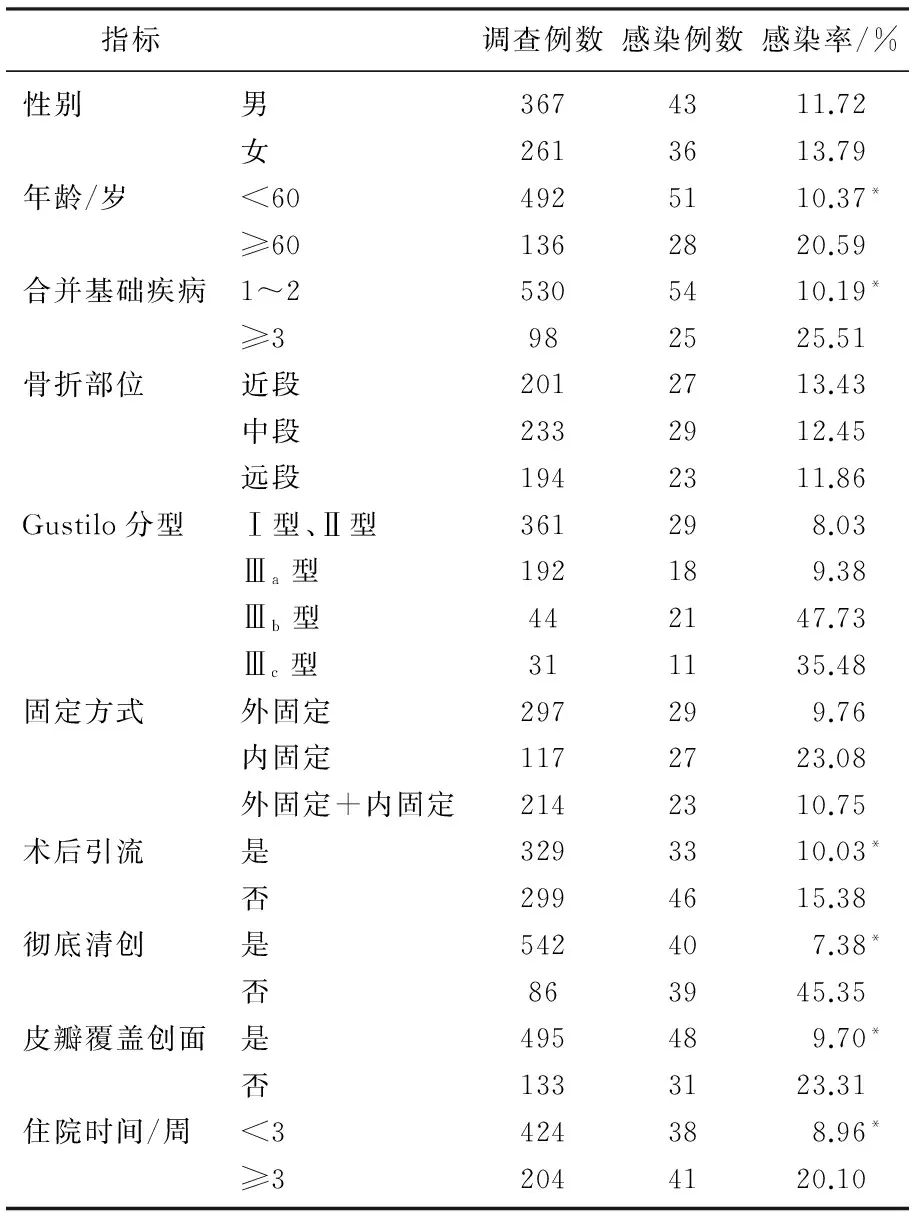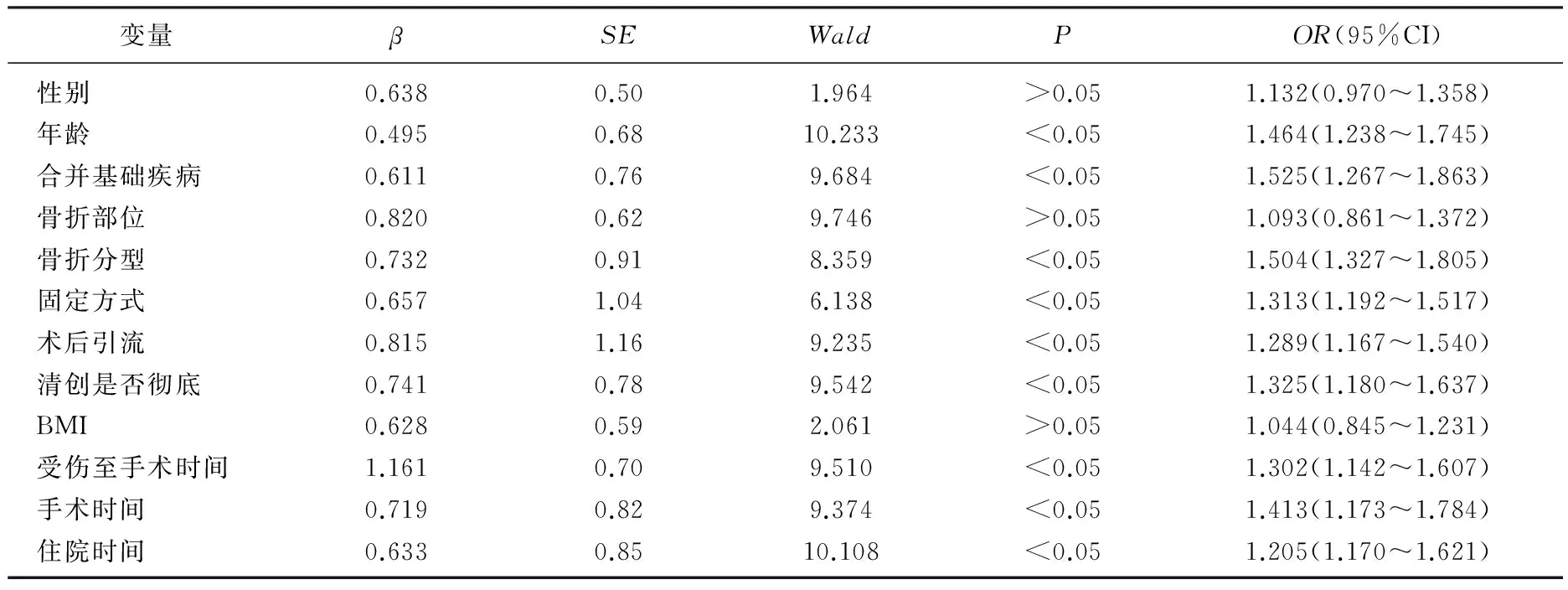胫腓骨开放骨折术后术区感染的多因素Logistic回归分析
2017-02-27刘颖
刘 颖
(中国中医科学院望京医院 骨科, 北京, 100102)
胫腓骨开放骨折术后术区感染的多因素Logistic回归分析
刘 颖
(中国中医科学院望京医院 骨科, 北京, 100102)
目的 回顾性研究胫腓骨开放骨折骨折术后术区感染发生的相关危险因素。方法 选择胫腓骨开放骨折患者628例, 术后术区感染患者49例(观察组),感染率为7.80%, 未发生感染患者579例(对照组)。评估感染患者相关危险因素。结果 患者年龄≥60岁、合并基础性疾病≥3种、Ⅲb型骨折分型、内固定方式、未术后引流、彻底清创、皮瓣覆盖创面和住院时间≥3周的感染率分别为20.59%、25.51%、47.73%、23.08%、15.38%、45.35%、23.31%、20.10%; 观察组患者受伤至手术时间和手术时间均显著高于对照组(P<0.05)。结论 年龄、合并基础疾病、骨折分型、固定方式、术后引流、清创是否彻底、受伤至手术时间、手术时间、住院时间均是胫腓骨开放骨折术后术区感染的相关危险因素。
胫腓骨骨折; 开放骨折术; 感染; Logistic回归分析
胫腓骨开放骨折是临床骨科常见创伤,胫腓骨除严重开放性骨折外,常合并严重软组织挫裂、神经血管的损伤、创面污染等。内固定手术是胫腓骨骨折临床常用手术方法,术区感染是术后患者严重的并发症,导致患者骨折愈合延迟,甚至难以愈合[1-2]。本研究探讨胫腓骨开放骨折骨折术后术区感染发生的相关危险因素,现报告如下。
1 资料与方法
1.1 一般资料
选择本院2012年1月—2015年12月胫腓骨开放骨折患者628例,其中男367例,女261例; 交通事故320例,坠落跌伤176例,钝器伤104例,其他28例。术后术区感染患者79例(观察组),感染率为12.58%,未发生感染患者579例。排除病例: 闭合性骨折、资料不全患者、入院时已有感染。
1.2 方法和指标
患者入院后均及时进行病情评估、处理危及生命的并发症,进行手术治疗[3]。采用回顾性研究方法,搜集所有患者的相关临床资料,主要包括患者的性别、年龄、合并基础疾病、骨折部位、骨折分型、固定方式、术后引流、清创是否彻底、体质量指数(BMI)、受伤至手术时间、手术时间、住院时间等。
1.3 统计学处理
本研究所有数据均应用SPSS 11.0统计软件进行统计分析。计量资料采用均数±标准差表示,采用t检验,计数资料比较采用χ2检验,并进行Logistic回归分析,P<0.05为差异有统计学意义。
2 结 果
2.1 患者术后术区感染相关因素比较
患者年龄≥60岁、合并基础性疾病≥3种、Ⅲb型骨折分型、内固定方式、未术后引流、彻底清创、皮瓣覆盖创面和住院时间≥3周的感染率分别为20.59%、25.51%、47.73%、23.08%、15.38%、45.35%、23.31%、20.10%, 均高于同组其他患者,差异有统计学意义(P<0.05), 见表1。
2.2 2组患者BMI、受伤至手术时间和手术时间比较
观察组患者受伤至手术时间和手术时间分别为(9.83±0.61) h和(3.70±0.41) h, 均显著高于对照组的(7.14±0.58) h、(2.52±0.34) h(P<0.05)。对照组和观察组BMI分别为(24.86±5.92)、(25.04±6.17) kg/m2, 差异无统计学意义(P>0.05)。
2.3 患者术后术区感染相关因素的Logistic回归分析
将性别、年龄、合并基础疾病、骨折部位、骨折分型、固定方式、术后引流、清创是否彻底、BMI、受伤至手术时间、手术时间、住院时间作为自变量,并分别赋值,患者术后术区感染率为因变量,进行Logistic分析,结果显示年龄、合并基础疾病、骨折分型、固定方式、术后引流、清创是否彻底、受伤至手术时间、手术时间、住院时间均与术后术区感染显著相关(P<0.05)。见表2。

表1 患者术后术区感染相关因素比较(n=628)
与同一指标另一亚项比较, *P<0.05。
3 讨 论
胫腓骨位于胫骨上下段移行交界处,是长管状骨中最常发生骨折的部位,胫腓骨解剖结构的独特性、开放性骨折断端直接暴露于伤口外侧、胫腓骨开放性骨折创伤严重、创伤面积较大,病情复杂,增加了术后发生皮肤坏死机会,使患者术后术区创面易受到感染,若处理不当,会给临床治疗及患者预后带来较大困难和严重影响[4-5]。
本研究结果显示,年龄较大、合并基础疾病患者感染率较高,患者因长期卧床、甚至伴有意识障碍,特别是老年人群机体抵抗力显著降低,部分患者因合并糖尿病、高血压等,增加了感染概率[6]。Ⅲb型骨折患者污染严重,增加感染的可能性[7]。胫腓骨开放性骨折术中骨折端缺乏有效固定,术后存在原始移位趋势使皮肤坏死、继发感染。胫腓骨内侧面覆盖较薄的皮肤和皮下组织,缺损致使钢板外露,血供较差,内固定术使薄弱的内侧皮肤张力增大,易导致皮肤坏死、感染。外固定支架固定可靠、减少骨膜及软组织的二次损伤,对骨折端血供影响小,有利于术后组织缺损、损伤的修复并可降低术后感染的发生[8-11]。治疗过程中,医师对患者骨折软组织损伤程度估计不足、伤口污染清创不彻底、异物的遗留等均可导致术后伤口发生感染。持续性引流可彻底引流出全创面的分泌物,减少分泌物对创面的刺激,还可促进局部血液循环,为伤口的早期愈合或植皮提供良好的条件[12-13]。骨折发生后及早控制病情、减少并发症,进行手术治疗,控制感染的发生。患者手术时间长,手术难度较高,损伤一般较大,也会延长住院时间,增加感染的可能性[14]。

表2 患者术后术区感染相关因素的多因素Logistic回归分析
[1] 王云清, 王爱国, 朱长喜, 等. 胫腓骨骨折患者术后切口难愈合的影响因素[J]. 创伤外科杂志, 2015, 17(4): 365-366.
[2] Geoffrey D. Hannigan, Nicholas Pulos, et al. Current Concepts and Ongoing Research in the Prevention and Treatment of Open Fracture Infections[J]. Adv Wound Care, 2015, 4(1): 59-74.
[3] Baoqing Yu, Gan Huang, Josiah T, et al. Single-incision technique for the internal fixation of distal fractures of the tibia and fibula: a combined anatomic and clinical study[J]. Arch Orthop Trauma Surg, 2013, 133(12): 1631-1637.
[4] 涂迎春, 林平, 马安军. 胫腓骨开放性骨折患者创口感染的病原学分析[J]. 中华医院感染学杂志, 2014, 24(8): 1967-1969.
[5] Melih Güven, Emrah Ceviz, Murat Demirel, et al. Minimally invasive osteosynthesis of adult tibia fractures by means of rigid fixation with anatomic locked plates[J]. Strategies Trauma Limb Reconstr, 2013, 8(2): 103-109.
[6] 高巍, 张文龙, 徐柏平. 外固定器结合封闭负压引流技术治疗胫腓骨骨折术后感染[J]. 中华医院感染学杂志, 2014, 24(10): 2523-2525.
[7] Apipop Kritsaneephaiboon, Tanawat Vaseenon, Boonsin Tangtrakulwanich. Minimally invasive plate osteosynthesis of distal tibial fracture using a posterolateral approach: a cadaveric study and preliminary report[J]. Int Orthop, 2013, 37(1): 105-111.
[8] 周斌, 陈勇杰, 唐令, 等. Gustilom型胫腓骨开放性骨折急诊清创后伤口闭合的时机与方法选择[J]. 浙江创伤外科, 2015, 20(5): 878-880.
[9] Vasanth Sathiyakumar, Rachel V Thakore, Rivka C. Ihejirika, et al. Distal tibia fractures and medial plating: factors influencing re-operation[J]. Int Orthop, 2014, 38(7): 1483-1488.
[10] Douglas N Beaman, Richard Gellman. Fracture Reduction and Primary Ankle Arthrodesis: A Reliable Approach for Severely Comminuted Tibial Pilon Fracture[J]. Clin Orthop Relat Res, 2014, 472(12): 3823-3834.
[11] 崔金雷, 宋文超, 李玉华. 胫腓骨开放性骨折患者创口感染的病原学与耐药性分析[J]. 中华医院感染学杂志, 2015, 25(16): 3683-3685.
[12] Hong-Wei Chen, Cong-Feng Luo. Extended anterolateral approach for treatment of posterolateral tibial plateau fractures improves operative procedure and patient prognosis[J]. Int J Clin Exp Med, 2015, 8(8): 13708-13715.
[13] 谭家昌, 杨有猛, 徐鸿育, 等. 早期清创有限内固定结合分期治疗胫腓骨开放性骨折[J]. 中国微创外科杂志, 2015, 15(10): 926-929.
[14] 赵琦辉, 倪凌之, 雷文涛. 胫腓骨开放骨折感染患者中药配合支架外固定疗效观察[J]. 中华医院感染学杂志, 2014, 24(24): 6190-6192.
Multivariate Logistic regression analysis in infection of operation area after operation for open fracture of tibia and fibula
LIU Ying
(DepartmentofOrthopedics,WangjingHospitalofChinaAcademyofChineseMedicalSciences,Beijing, 100102)
Objective To explore the related factors of infection in operation area after operation for open fracture of tibia and fibula. Methods A total of 628 patients with open fracture of tibia and fibula were selected. After operation, 49 cases with infection in operation area were designed as observation group, and the infection rate was 12.58%, while 579 cases without infection were designed as control group. The risk factors of infection were evaluated. Results The infection rates of the aged over and equal to 60 years old, patients with basic disease≥ 3 types, Ⅲbfracture, fixation of external fixation and internal fixation, postoperative drainage, thorough debridement and skin flap to cover the wound and hospitalization time≥ 3 weeks were 45.35%, 20.59%, 25.51%, 47.73%, 23.08%, 15.38%, 23.31% and 20.10% respectively. The injury to operation time and operation time in the observation group were significantly longer than those in the control group (P<0.05). Conclusion The risk factors of postoperative infection in operation area after open fracture of tibia and fibula were the age, basic disease, fracture classification, fixation, postoperative drainage, debridement and thorough debridement, the time of injury to the operation, operation time, and hospitalization time.
tibia and fibula fractures; open fracture surgery; infection; logistic regression analysis
2016-09-22
R 683
A
1672-2353(2017)01-075-03
10.7619/jcmp.201701022
